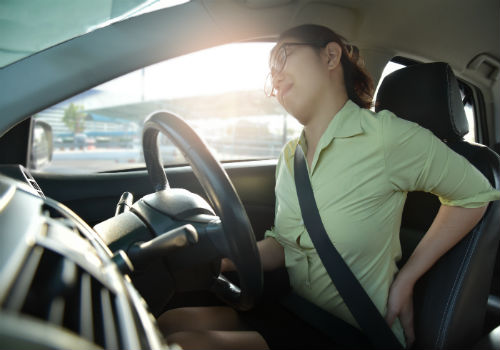Injuries and pain in the lower back muscles are one of the most common medical complaints around the world. Globally, back pain is the number one cause of disability and a leading reason for missed workdays. Each year, roughly 50% of working Americans complain of back pain symptoms.
One activity commonly linked with back pain is long distance driving. Whether you are taking a long drive for vacation or drive a long commute to work, these tips can help you maintain a healthy back and prevent pain.

How Can Driving Cause Lower Back Pain?
Lower back problems occur when driving in a few different ways — the most common of them being poor posture when at the wheel.
During a long car journey, it can be very easy to slouch in the driver seat and sink into a posture that puts uneven pressure on your spine and lower back muscles. Slouching and putting your spine out of position can put more pressure on certain muscles, causing an imbalance. This imbalance can cause them to tighten and spasm, which could lead to back pain.
External factors from the drive can also cause long term back pain. When driving, the vehicle vibrates. These vibration levels can increase fluid loss in the discs between your spine’s vertebrae. As a result, they become more brittle during a long drive and less effective at preventing spinal injuries.
Other factors like acceleration forces as well as the general movements of the car can also affect your lower back muscles.
When you consider that many car seats force you into a fixed position that doesn’t allow relief, it is clear to see why lower back pain and long-distance driving are so heavily connected.
Preventing Lower Back Pain Caused by Driving
Fortunately, there are some steps you can take to avoid injury and pain to your lower back during long journeys. Here’s a list of tips you can employ during your next trip:
1.Angle Your Seat Correctly
You want your entire back to remain in contact with your seat. A seat angle between 100 and 110 degrees is best for achieving this. The base of your back should sit against the bottom of the backrest to support the natural s-curve of your spine.
2. Adjust the Headrest
When you rest your head back, the middle of the back of your head should align with the mid-point of the headrest cushion. Keeping the head upright and straight helps the spine stay straight, making back pain less likely to occur.
3. Use Cruise Control
When your feet are suspended on the pedals, they aren’t supporting your weight as efficiently as they should be. As a result, the emphasis on support shifts to the lower back. If your car has a cruise control feature, using it will allow you to place your feet on a firmer, more stable surface for proper support.
4. Stretch and Movement Breaks
Being fixed in a seated position for long periods can cause stiffness, cramps, and spasms. Getting your hips, back and knees moving every couple of hours can go a long way to reducing lower back pain. A short walk and stretch every so often are all it takes.
When to Seek Professional Lower Back Pain Treatment

Sometimes, lower back pain can become a bigger issue than some simple stretches or posture changes can solve. In such instances, professional treatment should be sought.
For individuals who regularly drive long-distances, professional treatments can be used in conjunction with the tips above as a preventative measure to keep your lower back free from injury and pain.
Chiropractors are experts in back pain; they can help to both cure and prevent it through a combination of lower back pain exercises, stretches, massages, and adjustments.








